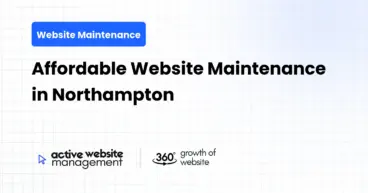December 11, 2024
8 min read
Maintaining an Angular website is crucial to ensure its smooth functioning, security, and performance. Angular, as one of the most popular frameworks for building dynamic, single-page web applications (SPAs), requires periodic maintenance to keep up with evolving technologies and user expectations. Regular updates, bug fixes, performance optimizations, and security measures are all part of a comprehensive website maintenance strategy.
In this article, we will dive deep into the essential maintenance tasks that Angular website owners and developers should consider. This guide will provide you with practical insights, actionable tips, and best practices for maintaining your Angular website efficiently. So, whether you’re a seasoned Angular developer or just starting out, this article will help you keep your Angular website in top shape.
1. Introduction to Angular Website Maintenance
Angular is an open-source framework created and maintained by Google, and it is widely used for building powerful web applications. Whether it’s for a small blog or a large enterprise application, Angular websites need regular maintenance to ensure they remain secure, functional, and up to date with the latest best practices.
Website maintenance refers to all the tasks required to keep a website running efficiently and securely. It includes updating software, monitoring performance, optimizing speed, fixing bugs, and ensuring that security vulnerabilities are patched. Angular websites, with their dynamic components and client-side rendering, have specific maintenance needs that differ from traditional server-rendered websites.
2. Why Angular Website Maintenance Is Important
Maintaining an Angular website goes beyond just fixing bugs. Here are some key reasons why maintenance is crucial:
- Security: Keeping your Angular website up to date with the latest security patches is vital to protect your site from potential vulnerabilities.
- Performance: Over time, the performance of your Angular website may degrade. Regular optimizations ensure that the site remains fast and responsive for users.
- Compatibility: As web standards evolve, it’s important to ensure that your Angular website is compatible with the latest browsers and devices.
- User Experience: Regular updates and fixes ensure a seamless user experience, reducing friction and increasing engagement.
3. Regular Updates and Version Management
Don’t Just Maintain Your Website—
Grow It using Active Website Management! Don't Wait for Growth—Accelerate It with Active Website Management
Why Update Angular Regularly?
One of the most critical maintenance tasks for any Angular website is keeping the framework up to date. Angular, like any other software, evolves over time. New versions introduce bug fixes, new features, and performance enhancements. By updating Angular, you ensure that your website benefits from these improvements.
Regularly updating Angular also helps in maintaining security. With each new release, known vulnerabilities are addressed, minimizing the risk of exploitation.
How to Update Angular Framework
Updating Angular involves several steps. Here’s a general process:
- Check Your Current Version: To check the current version of Angular you’re using, run the following command in the terminal:Copy code
ng version - Review Angular Change Logs: Before updating, review the change logs to see what’s new in the version you’re upgrading to. This helps you understand the potential impact on your application.
- Run Angular Update Command: Angular provides an
ng update command to help you easily update your dependencies. You can update Angular CLI and core libraries by running:sqlCopy codeng update @angular/cli @angular/core - Test Your Application: After updating, run tests and manually check the functionality to ensure everything works as expected.
- Fix Breaking Changes: Occasionally, new versions of Angular introduce breaking changes. Review the documentation for instructions on how to resolve any issues.
By performing these updates regularly, you can avoid falling behind and ensure your website remains current with the latest improvements.
A fast, responsive website is critical for user retention and SEO. Angular websites, if not optimized properly, can suffer from slow loading times and poor performance. Here are some key performance optimization techniques:
Lazy Loading
Lazy loading allows you to load parts of your website only when necessary. This reduces the initial load time, improving performance. Angular supports lazy loading through its routing mechanism. By configuring the routes to load modules lazily, you can decrease the initial bundle size and improve performance.
Change Detection Strategy
Angular uses change detection to update the view when the state of the application changes. By default, Angular checks the entire component tree to detect changes, which can be inefficient for large applications. You can optimize performance by setting the change detection strategy to OnPush, which ensures that Angular only checks a component when its input properties change.
AOT Compilation
Ahead-of-Time (AOT) compilation is another optimization that improves the performance of Angular websites. AOT compiles the application during the build phase rather than at runtime, reducing the time it takes for the application to load. Enabling AOT in production builds is a best practice for improving performance.
5. Security Maintenance
Patching Vulnerabilities
Security vulnerabilities can be exploited by malicious actors to harm your website and users. Angular often releases security patches for known vulnerabilities. Keeping your dependencies updated is a good first step in protecting your website from such threats.
You should also keep an eye on Angular’s security advisories and implement patches as soon as possible.
Regular Security Audits
It’s important to conduct regular security audits on your Angular website to identify potential security risks. This involves reviewing your code, dependencies, and server settings to ensure they follow best security practices.
Don't Wait for Growth—Accelerate It with
Active Website Management Don't Wait for Growth—Accelerate It with Active Website Management
Secure API Integration
If your Angular website communicates with a backend server through APIs, ensure that these APIs are secure. Use proper authentication (OAuth, JWT), secure endpoints with HTTPS, and validate inputs to prevent common attacks like SQL injection and cross-site scripting (XSS).
6. Database and Backend Maintenance
While Angular is focused on the frontend, the backend and database of your website also need regular maintenance. Here are some key tasks:
Database Optimization
Database optimization is crucial for ensuring that your Angular website performs well, especially when dealing with large amounts of data. Regularly review your database schema and queries for performance issues, and consider indexing critical columns.
Backend API Monitoring
Backend APIs that serve data to your Angular website should be monitored for performance and uptime. Set up automated tests to check the availability of your APIs and fix any issues promptly to ensure a smooth user experience.
7. Testing and Bug Fixing
Automated Testing for Angular
Automated testing is essential for ensuring that your Angular website works correctly after updates or changes. Angular supports several testing frameworks like Jasmine, Karma, and Protractor. Use these tools to run unit tests and end-to-end tests.
Unit and End-to-End Testing
Unit testing ensures that individual components and services work as expected, while end-to-end testing simulates real-world user interactions to ensure the entire system functions smoothly.
8. User Experience and Frontend Maintenance
Cross-browser Compatibility
Angular websites should work seamlessly across all modern browsers. Regularly test your website on different browsers like Chrome, Firefox, Safari, and Edge to ensure cross-browser compatibility.
Responsive Design
With the growing use of mobile devices, a responsive design is no longer optional. Ensure that your Angular website is optimized for different screen sizes, from mobile phones to desktops.
9. Active Website Management
AWM -Monitoring Site Health
Regular monitoring of your website’s health is crucial for identifying issues before they affect users. Use tools like Google Analytics, New Relic, or Site24x7 to track uptime, page load speed, and error rates.
Error Logs and Analytics
Set up logging and error tracking for your Angular website. Tools like Sentry or LogRocket can capture errors and performance bottlenecks in real time. By analyzing these logs, you can quickly fix issues that may arise.
Content Updates and SEO
Regular content updates not only keep your website fresh and engaging but also improve SEO. Ensure that all new content is optimized with relevant keywords, meta descriptions, and proper headings to boost search engine rankings.
10. Internal and External Links Management
Internal Link Management Best Practices
Internal links are important for SEO and for improving site navigation. Always ensure that your Angular website’s internal links are up to date and pointing to relevant pages. A well-organized internal linking structure helps search engines crawl your site effectively.
External Link Management Best Practices
External links to authoritative websites can enhance your site’s credibility. Ensure that external links are functional and up to date. Regularly check for broken links and remove or replace them with relevant, high-quality sources.
11. Conclusion
Maintaining an Angular website is an ongoing task that requires attention to detail and regular updates. From keeping the framework up to date to optimizing performance, ensuring security, and enhancing user experience, there are many critical tasks to focus on. By following the best practices outlined in this article, you can ensure that your Angular website remains fast, secure, and user-friendly.
Additionally, don’t forget the importance of active website management. Regular monitoring, content updates, and proper link management will help keep your website performing at its best.
By taking a proactive approach to maintenance, you can maximize the longevity and success of your Angular website.






